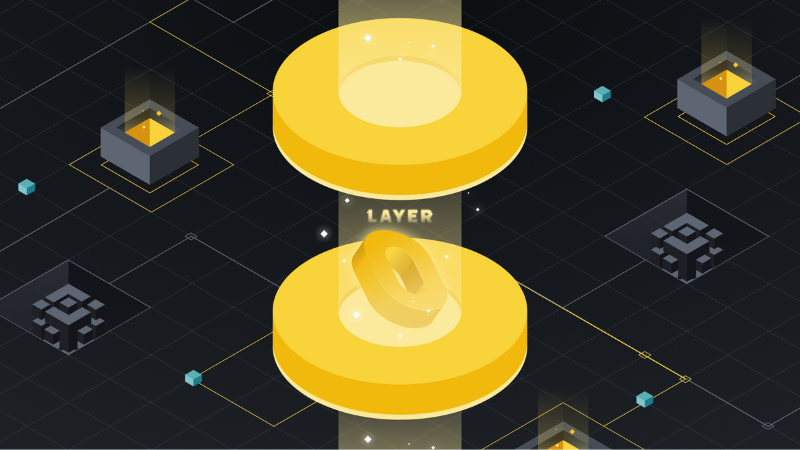Blockchain Layer 1 is the foundational layer of blockchain networks, playing a crucial role in providing the infrastructure for decentralized applications (dApps), smart contracts, and transactions. Unlike layers that rely on other underlying layers, Blockchain Layer 1 operates independently, being responsible for security, consensus, and transaction processing for the entire network. With its critical role in developing and maintaining the blockchain ecosystem, Layer 1 is not only the foundation for applications but also ensures the stability and security of all transactions and smart contracts.
What is Blockchain Layer 1?
Blockchain Layer 1 is the base layer of a blockchain network, serving as the foundational platform to support and develop decentralized applications (dApps), smart contracts, and transaction validation. It provides essential features such as security, consensus, and scalability for the blockchain network.

Key Features of Blockchain Layer 1
- Independent Infrastructure: Blockchain Layer 1 functions as an independent platform and does not rely on any other network. It is responsible for processing transactions, maintaining the distributed ledger, and validating smart contracts.
- Ensuring Security and Consensus: Blockchain Layer 1 networks employ their own consensus mechanisms (such as Proof of Work or Proof of Stake) to protect the integrity and security of data within the network. This is essential for the operation of dApps and Layer 2 blockchain solutions built on this platform.
- Scalability and Performance: Blockchain Layer 1 networks are designed to scale and optimize the processing of large transaction volumes. However, they may face scalability issues as transaction numbers increase. Solutions like sharding and other mechanisms are being developed to address these challenges.
- Creating New Protocols: Developers can use Blockchain Layer 1 to build new protocols and applications without the need to create a new blockchain or token. This makes Layer 1 a flexible platform for the development of blockchain projects.
Types of Blockchain Layer 1 Scalability Solutions
Blockchain Layer 1 scalability solutions help improve the scalability and efficiency of blockchain networks, reducing congestion and transaction costs. Below are three main methods:
New Consensus Protocol: Switching from Proof-of-Work to Proof-of-Stake
Proof of Work (PoW) is a commonly used consensus mechanism but is slow and resource-intensive, especially when processing many transactions. While PoW ensures security and decentralized consensus, its scalability is limited.
Proof of Stake (PoS) is an alternative that improves transaction validation speed by utilizing validators’ stakes rather than computational resources. PoS reduces energy consumption and speeds up processing; however, it may not be as secure as PoW in some cases.
Database Partitioning: Sharding
Sharding is a method of dividing the blockchain network into separate partitions (shards), where each shard handles a subset of transactions and data. This reduces the load on each node in the network, allowing faster transaction speeds and more efficient workload distribution. Each shard processes transactions and stores data independently, rather than requiring each node to store the entire blockchain.
Increasing Block Size: Handling More Transaction
Hard forking is the process of making fundamental changes to the attributes of a blockchain network, such as increasing block size. By enlarging the block size, more transactions can be processed in each block, improving performance and reducing transaction times.

Exploring the Advantages and Disadvantages of Blockchain Layer 1
Advantages of Blockchain Layer 1
- High Security and Decentralization: Blockchain Layer 1 networks, such as Bitcoin and Ethereum, use decentralized consensus mechanisms like Proof-of-Work or Proof-of-Stake, ensuring high security and protecting the network from attacks. Transactions are recorded on a public, immutable ledger, enhancing transparency and security.
- Autonomy: Blockchain Layer 1 networks operate independently without relying on any other blockchain layer or platform. This provides autonomy to the network, with complete control over transactions, smart contracts, and dApps (decentralized applications).
- Flexibility in Development: Layer 1 provides a powerful platform for developers to build decentralized applications (dApps), smart contracts, and blockchain protocols without the need for dependencies on other layers.
- Scalability Through Improvements: Blockchain Layer 1 networks are continuously evolving to improve scalability by upgrading consensus protocols, such as Ethereum’s transition to Proof-of-Stake, or using technologies like sharding to enhance transaction processing speeds.
Disadvantages of Blockchain Layer 1
- Limited Scalability: One of the major issues with Blockchain Layer 1 networks, especially Bitcoin and Ethereum, is their limited ability to process transactions. The low transactions per second (TPS) can cause network congestion as transaction volume increases, leading to higher transaction fees and longer confirmation times.
- High Costs and Energy Consumption: Consensus mechanisms like Proof-of-Work (PoW) require significant computational power and energy, leading to high costs for network maintenance. This makes Layer 1 blockchains like Bitcoin less energy-efficient and more expensive for participants.
- Imperfect Security: While Proof-of-Work and Proof-of-Stake mechanisms provide certain levels of security, they are not flawless. For instance, PoW can lead to network congestion during overload, while PoS may not be robust enough to defend against attacks if there are insufficient participants or uneven distribution of stakes.
- Slow Development: Traditional Blockchain Layer 1 networks can be difficult to modify or update compared to other systems. Although upgrades can improve scalability, they often face consensus challenges within the community, potentially leading to splits in the network

In conclusion, Blockchain Layer 1 serves as the backbone of blockchain technology, providing the essential infrastructure for decentralized applications, smart contracts, and transaction processing. Its independent operation, combined with robust security mechanisms like Proof-of-Work and Proof-of-Stake, ensures that the network remains secure and decentralized. However, the challenges of scalability, high energy consumption, and limited transaction throughput must be addressed to further enhance the performance and adoption of Layer 1 networks. As the blockchain space continues to evolve, solutions like sharding, Proof-of-Stake, and block size increases are paving the way for more efficient and scalable Layer 1 platforms.
To stay updated on the latest trends and opportunities in the world of finance and cryptocurrency, be sure to follow Financial Insight Daily. We provide in-depth insights and the most up-to-date information on blockchain projects and trends that are shaping the market
